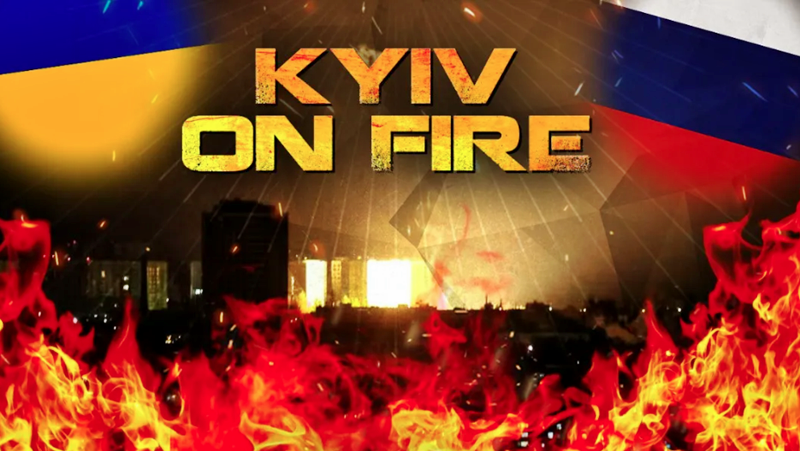Nazi Occupied Kyiv Came Under One Of Most Massive Russian Combined Attacks

By Intel Drop-24 April 2025
Nazi Occupied Kyiv Came Under One Of Most Massive Russian Combined Attacks.
On the night of April 23-24, 2025, Russian forces launched one of the largest combined missile and drone attacks on Ukraine in recent months, targeting multiple regions with a mix of ballistic and cruise missiles, as well as numerous kamikaze drones.
According to the Air Force of the Armed Forces of Ukraine, Russian attack involved 70 missiles of various types, including Iskander-M ballistic missiles, Kh-101 cruise missiles launched from Tu-95MS strategic bombers, Kalibr sea-based missiles, and guided aviation missiles, alongside 145 Shahed-type attack drones and decoy UAVs. Ukrainian air defenses allegedly intercepted 48 missiles and 64 drones, while 68 decoy drones disappeared. Though footage from different Ukrainian cities confirmed devastating Russian strikes on military-industrial facilities, logistics hubs, and critical infrastructure.
Map of night strikes by Ukrainian sources
Kyiv bore the brunt of the attack, with explosions reported near the central railway station and suspected air defense locations, while Kharkiv, Dnipro, Zhytomyr, and Pavlograd also sustained massive strikes. Devastating strikes were recorded in at least ten Ukrainian regions.
Russian officials framed the strikes as retaliation for Ukraine’s alleged violations of the Easter truce and emphasized targeting defense industry sites, including tank repair plants and weapons production facilities. The press service of the Russian Ministry of Defense said that the Russian military also attacked enterprises in the aviation, rocket, space and machine-building industries, as well as factories where gunpowder is produced. The Defense Ministry reported that the strikes had reached their targets and hit them.
The Kremlin commented on the night strikes:
The Easter truce has ended, and it has been repeatedly violated by the Ukrainian side. The Ukrainian side continues its propaganda. Our military continues the Special Military Operation. Now Russian military continues to fulfill their tasks assigned to them by the Supreme Commander-in-Chief. As part of this, military and near-military targets continue to be attacked.
Kyiv’s air defenses were overwhelmed, with sustained drone strikes gradually degrading interception capabilities. Preliminary reports indicate that missile strikes targeted critical transport infrastructure, including the Kyiv-Pasazhyrskyi railway station, as well as locations of Western-supplied air defense systems near the Lukianivska metro station. Ukrainian media shared footage purportedly showing intercepted missiles detonating over densely populated areas, resulting in collateral damage to residential buildings and civilian casualties.
Kharkiv Mayor Ihor Terekhov reported that the city was hit by 14 drone strikes and 10 missiles overnight. He confirmed damage to industrial facilities. One of the targets was reportedly the Malyshev Plant, a key producer and repair hub for Ukrainian military vehicles, along with the city’s airport. The local railway infrastructure was also reportedly hit. Residential buildings, a clinic, a school, and a hotel complex also sustained damage, with some destruction potentially caused by falling debris from intercepted projectiles. However, Ukrainian forces are largely using such civilian structures for military purposes.
The city of Zhytomyr came under massive strikes, with the area of the Ozernoye military airfield and a unit of the State Emergency Service pounded by drones and missiles. A section of the local railway was also damaged. According to local reports, a military train was destroyed in the region.
UPDATE: The Zhytomyr Armored plant was hit by rockets and kamikaze drones last night. Fires on the territory of the enterprise have engulfed workshops and the local energy substation, as well as parking lots.
Ukrainian military-industrial complex enterprises and transport infrastructure were pounded in Pavlograd. Kalibr missile strikes were recorded in the vicinity of the town of Skalat in the Ternopil region.
After the Easter Truce, Russian strikes became more severe. The Ukrainian military acknowledged challenges in repelling the barrage due to depleted air defense resources, with Interior Minister Ihor Klymenko admitting shortages in intercepting such large-scale attacks. In their turn, NATO sources note that the Russian command takes full advantage of the depletion of the Ukrainian air defense, which allows the mass use of the most vulnerable cruise missiles from the Russian arsenal. The attack prompted President Volodymyr Zelensky to urge Western allies to expedite air defense reinforcements.
At the same time, Russia also faced wave of Ukrainian drone attacks at night, with 87 UAVs downed over Crimea, Belgorod, and even near Moscow, though no major damage was reported.
The escalation signals a return to intensified strikes following the lull of the holiday period, with the Russian military leveraging its evolving arsenal in a protracted attritional battle. NATO assessments noted Russia’s strategic exploitation of Ukraine’s air defense gaps, particularly through saturation attacks designed to overwhelm interception capabilities.
Support SouthFront

Tags:#strikes, Kharkiv, Kyiv, Pavlograd, russia, ukraine, Zhitomir